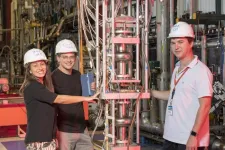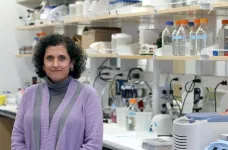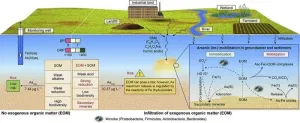(Press-News.org) LA JOLLA (July 21, 2023)—Salk Institute researchers, in collaboration with the National Institutes of Health, have discovered the molecular mechanisms by which the human immunodeficiency virus (HIV) becomes resistant to Dolutegravir, one of the most effective, clinically used antiviral drugs for treating HIV.
The new study, published July 21, 2023 in Science Advances, reveals how changes to the 3D structures of integrase, an HIV protein, can lead to Dolutegravir resistance and how other compounds may be able to overcome this resistance.
“With HIV, one must think two steps ahead of the virus,” says Salk Associate Professor Dmitry Lyumkis, co-senior author and the Hearst Foundation Developmental Chair. “We’ve now determined how the virus could continue evolving against drugs like Dolutegravir, which is important to consider for the development of future therapeutics.”
HIV infection depends on the ability of the virus to paste its own genetic material into the genomes of human cells, essentially hijacking the cells to become virus-producing factories. Dolutegravir and related drugs work by blocking integrase, a protein critical to the ability of the virus to integrate its own DNA into the host genome. Without functioning integrase, HIV can’t effectively infect human cells. However, HIV is a rapidly mutating virus, and an increasing number of HIV strains are resistant to Dolutegravir.
In the past, Lyumkis’ lab discovered the 3D structure of the integrase protein while attached to DNA as well as exactly how drugs like Dolutegravir bind to and block integrase. But researchers weren’t sure how the integrase structure changed when the virus stopped responding to Dolutegravir.
In the new study, Lyumkis and collaborators from the National Institutes of Health created versions of the integrase protein with mutations known to make HIV resistant to Dolutegravir. Then they determined the structure of each mutant integrase, revealing why Dolutegravir could no longer bind to and block each version of the protein. The scientists also evaluated the “fitness” of the virus (its capacity to produce infectious descendants) and the activity of the enzyme to better understand what leads to drug resistance in patients.
“We were quite surprised by the magnitude of resistance that these integrase variants had,” says Lyumkis. “The ability of Dolutegravir to function was completely compromised.”
The researchers also tested the efficacy of an experimental HIV drug, 4d, to block the function of Dolutegravir-resistant integrase proteins. 4d was developed by Lyumkis’ collaborators at the NIH as a next-generation integrase-targeting drug and is currently in pre-clinical animal trials. In all the variants, they discovered that 4d still potently blocked the ability of HIV to integrate its genes into human cells. This suggests that 4d or variants of this compound may be effectively used to treat the virus in patients who have developed resistance to Dolutegravir.
The structural data on how 4d binds to the Dolutegravir-resistant integrase proteins also hinted at how new drugs could overcome drug resistance.
“4d is really just an example of how to combat drug resistance, but it provides us with some basic principles that we can learn from to design other therapeutics,” says co-senior author Robert Craigie of the National Institute of Diabetes and Digestive and Kidney Diseases (NIDDK), part of the National Institutes of Health. “The way a section of the 4d molecule stacks like a flat sheet on top of a section of the integrase protein-DNA assembly could be replicated in other compounds.”
Next, the scientists will study how integrase variants evolve—including those not yet seen in patients but possible in the future—and how they impact response to the best clinically used drugs as well as the ability of HIV to infect humans.
Other authors include Dario Oliveira Passos, Zelin Shan, Avik Biswas and Timothy S. Strutzenberg of Salk; Min Li, Zhaoyang Li, Steven J. Smith, Xue Zhi Zhao, Terrence R. Burke, Jr. and Stephen H. Hughes of the National Institutes of Health; Qinfang Sun, Indrani Choudhuri, Allan Haldane, and Ronald M. Levy of Temple University; Nanjie Deng of Pace University; and Lorenzo Briganti and Mamuka Kvaratskhelia of University of Colorado Anschutz Medical Campus.
The work was supported by the National Institutes of Health (U01 AI136680, R01 AI146017, U54 AI170855, R35 GM132090), the NIDDK Intramural Program, the Margaret T. Morris Foundation, the Hearst Foundation, the NIH Intramural Program, the Center for Cancer Research, the National Cancer Institute, the NIH AIDS Intramural Targeted Program, and an F32 Postdoctoral Fellowship (GM148049).
The content in this release is the sole responsibility of the authors and does not represent the official views or imply enforesment of the National Institutes of Health.
END
Revealing HIV drug-resistance mechanisms through protein structures
New Salk Institute research could lead to the development of new HIV therapeutics that overcome resistance to existing drugs
2023-07-21
ELSE PRESS RELEASES FROM THIS DATE:
New sensor mimics cell membrane functions
2023-07-21
CAMBRIDGE, MA -- Drawing inspiration from natural sensory systems, an MIT-led team has designed a novel sensor that could detect the same molecules that naturally occurring cell receptors can identify.
In work that combines several new technologies, the researchers created a prototype sensor that can detect an immune molecule called CXCL12, down to tens or hundreds of parts per billion. This is an important first step to developing a system that could be used to perform routine screens for hard-to-diagnose cancers or metastatic tumors, or as a highly biomimetic electronic “nose,” ...
The Pacific slope of Peru is greening, and this is not good news
2023-07-21
Analysing satellite data spanning the past 20 years, the research team based at the Cavendish Laboratory in Cambridge examined how vegetation has been changing along the Pacific coast of Peru and northern Chile. This area is known for its unique and delicate arid and semi-arid environments.
The analysis revealed that certain areas experienced positive vegetation growth, known as greening, while others displayed negative trends, referred to as browning. Unsurprisingly, the changes in vegetation are influenced by things like farming and urban development or change in ...
Dark SRF experiment at Fermilab demonstrates ultra-sensitivity for dark photon searches
2023-07-21
Scientists working on the Dark SRF experiment at the U.S. Department of Energy’s Fermi National Accelerator Laboratory have demonstrated unprecedented sensitivity in an experimental setup used to search for theorized particles called dark photons.
Researchers trapped ordinary, massless photons in devices called superconducting radio frequency cavities to look for the transition of those photons into their hypothesized dark sector counterparts. The experiment has put the world’s best constraint on the dark photon existence in a specific mass range, as ...
Extracellular vesicles could aid spread of scleroderma-caused fibrosis throughout body
2023-07-21
Extracellular vesicles, responsible for cell-to-cell communication, might be a driver of fibrosis in systemic sclerosis, according to a recent paper in Arthritis and Rheumatology.
Characterized by stiff and hardening tissue known as fibrosis, systemic sclerosis – also known as scleroderma – can affect the skin as well as other organs. Most research has focused on the pathology and starting point of fibrosis, but researchers at the Medical University of South Carolina are focusing ...
Ricardo Valerdi named Head of Systems and Industrial Engineering at the University of Arizona
2023-07-21
Ricardo Valerdi was selected as head of the Department of Systems and Industrial Engineering after a national search that yielded a highly competitive pool of candidates after serving as interim head for the 2022-2023 academic year.
“When I joined SIE 12 years ago, it looked very different,” said Valerdi. “Today we have a new generation of talented and ambitious faculty who are impacting our society’s Grand Challenges in manufacturing, transportation, aerospace ...
BioIVT to discuss its pivotal role in liquid biopsy research at the AACC Annual Scientific Meeting and Clinical Lab Expo
2023-07-21
BioIVT, a global research partner and biospecimen solutions provider for drug and diagnostic development, today announced that it will highlight the integral role it is playing in liquid biopsy research at the American Association for Clinical Chemistry (AACC) Annual Scientific Meeting and Clinical Lab Expo. This conference will be held from July 23-27 at the Anaheim Convention Center in Anaheim, CA.
“Liquid biopsy research can revolutionize the way we detect, diagnose, and treat diseases. However, several issues need to be resolved before it can reach its full potential. They include adopting ...
Father’s psychiatric diagnosis increases risk of preterm birth, study reports
2023-07-21
Babies are more likely to be born prematurely when either their father or mother has had a psychiatric diagnosis, according to a study conducted by researchers at the Icahn School of Medicine at Mount Sinai and the Karolinska Institutet and published July 20 in the open access journal PLOS Medicine.
The research shows, for the first time, that the risk of preterm birth is higher in infants whose father or mother has a psychiatric diagnosis than in those whose parents do not, and higher still when both parents have such diagnoses.
Preterm ...
Multi-society statement on US Supreme Court ruling on students for fair admissions
2023-07-21
ROCKVILLE, MD—JULY 19, 2023 – As organizations representing a wide range of scientific, engineering, and mathematical disciplines, we will not be deterred by the U.S. Supreme Court ruling on race considerations in college and university admissions.
America’s inherent strength and economic competitiveness among nations is its domestic and international talent across every race, ethnicity, gender, and geography. To meet current and emerging job demands and retain our research and development leadership globally, we must broaden who participates in science, technology, engineering, mathematics, and medicine. Doing so will improve lives, advance our nation’s living standards, ...
Harnessing machine learning for early cancer detection in primary care
2023-07-21
“[Machine learning] has the potential to transform early cancer detection in primary care [...]”
BUFFALO, NY- July 21, 2023 – A new editorial paper was published in Oncoscience (Volume 10) on June 9, 2023, entitled, “Transforming early cancer detection in primary care: harnessing the power of machine learning.”
Cancer remains a significant global health burden, and early detection plays a crucial role in improving patient outcomes. Primary care settings serve as frontline gatekeepers, providing an opportunity for early detection through symptom assessment and ...
New study uncovers potential risk of arsenic release from sediment under organic matter influence
2023-07-21
Researchers from the Chinese Research Academy of Environmental Sciences have conducted a study to assess the impact of environmental factors and microbial communities on the mobilization of arsenic (As). The findings, published in Volume 15 of the journal Environmental Science and Ecotechnology, reveal important insights into the biogeochemical processes involved in As release. The study focused on processes such as desorption, reduction, complexation, and co-precipitation that affect the As behaviour in the environment. The interaction ...
LAST 30 PRESS RELEASES:
Ambitious model fails to explain near-death experiences, experts say
Multifaceted effects of inward foreign direct investment on new venture creation
Exploring mutations that spontaneously switch on a key brain cell receptor
Two-step genome editing enables the creation of full-length humanized mouse models
Pusan National University researchers develop light-activated tissue adhesive patch for rapid, watertight neurosurgical sealing
Study finds so-called super agers tend to have at least two key genetic advantages
Brain stimulation device cleared for ADHD in the US is overall safe but ineffective
Scientists discover natural ‘brake’ that could stop harmful inflammation
Tougher solid electrolyte advances long-sought lithium metal batteries
Experts provide policy roadmap to reduce dementia risk
New 3D imaging system could address limitations of MRI, CT and ultrasound
First-in-human drug trial lowers high blood fats
Decades of dredging are pushing the Dutch Western Scheldt Estuary beyond its ecological limits
A view into the innermost workings of life: First scanning electron microscope with nanomanipulator inaugurated in hesse at Goethe University
Simple method can enable early detection and prevention of chronic kidney disease
S-species-stimulated deep reconstruction of ultra-homogeneous CuS nanosheets for efficient HMF electrooxidation
Mechanical and corrosion behavior of additively manufactured NiTi shape memory alloys
New discovery rewrites the rules of antigen presentation
Researchers achieve chain-length control of fatty acid biosynthesis in yeast
Water interactions in molecular sieve catalysis: Framework evolution and reaction modulation
Shark biology breakthrough: Study tracks tiger sharks to Maui mating hub
Mysterious iron ‘bar’ discovered in famous nebula
World-first tool reduces harmful engagement with AI-generated explicit images
Learning about public consensus on climate change does little to boost people’s support for action, study shows
Sylvester Cancer Tip Sheet for January 2026
The Global Ocean Ship-Based Hydrographic Investigations Program (GO-SHIP) receives the Ocean Observing Team Award
Elva Escobar Briones selected for The Oceanography Society Mentoring Award
Why a life-threatening sedative is being prescribed more often for seniors
Findings suggest that certain medications for Type 2 diabetes reduce risk of dementia
UC Riverside scientists win 2025 Buchalter Cosmology Prize
[Press-News.org] Revealing HIV drug-resistance mechanisms through protein structuresNew Salk Institute research could lead to the development of new HIV therapeutics that overcome resistance to existing drugs










